#national historic landmark district
Text

NPS Photo of Mount Rainier with a portion of Mowich Lake Road viewed from Tolmie Peak in 1961 (Eunice Lake is in the foreground with Mowich Lake in the distance).
Mowich Lake Road, like other park roads, was initially planned as part of an “around-the-mountain” road system. Mowich Lake Road starts in the northwest corner of the park and was intended to connect to Westside Road, which starts from the southwest corner. The two roads were never completed due to budget constraints and the rugged topography of the mountain. Constructed from 1929-1934, Mowich Lake Road remains a six-mile long spur road (reached via SR165) and is a discontiguous portion of the Mount Rainier National Historic District. Original features along the road include one stone retaining wall and 39 rustic culverts with mortared stone headwalls.

Mount Rainier National Park Archives Photo of the Mowich Entrance Dedication in 1933.
Mowich Lake Road was dedicated in 1933 at the Mowich Lake Entrance (now at Paul Peak Trailhead). At the dedication, a log memorial was constructed in honor of Dr. William Fraser Tolmie who visited Mount Rainier a hundred years earlier in 1833 on a botanizing trip. The log memorial was intended to be incorporated into an entrance arch. The arch was never completed and the memorial no longer exists. Footage of the Mowich Lake Road dedication event can be viewed at: https://go.nps.gov/MMem-MowichDedication

NPS Photo of the current Mowich Lake Road Entrance at Paul Peak Trailhead, 8/17/23.
While dedicated in 1933, delays due to construction and then WWII limited access and Mowich Lake Road did not open to vehicle traffic until July 1955. Have you traveled the historic Mowich Lake Road?
#Historic Mount Rainier#mount rainier national park#Mowich Lake#Mowich Lake Road#Paul Peak#Paul Peak Trailhead#historic road#national historic landmark district#history
63 notes
·
View notes
Text



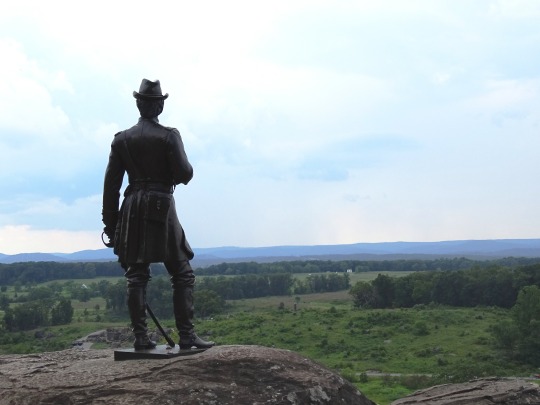


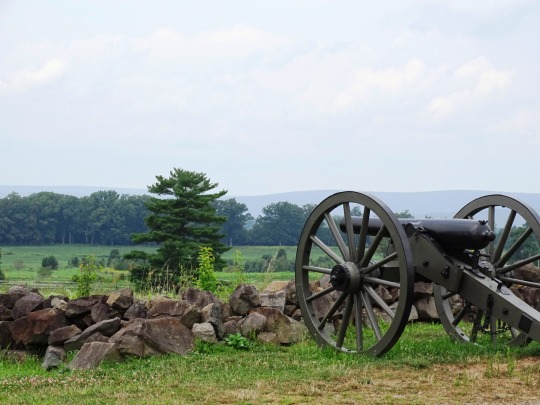

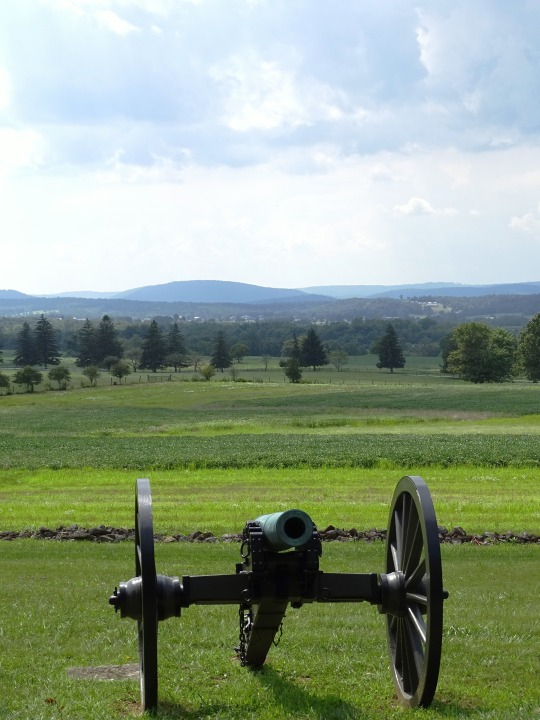
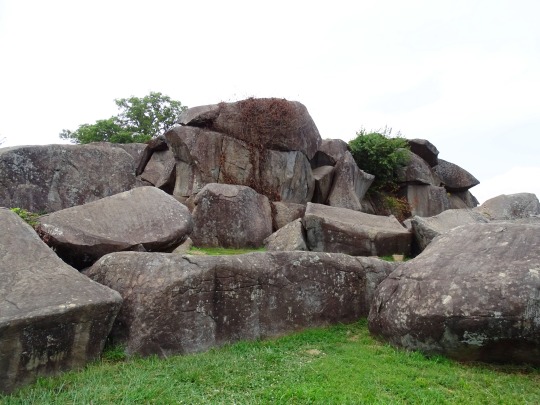
The Second Day of the Battle of Gettysburg was on July 2, 1863.
#Second Day of the Battle of Gettysburg#2 July 1863#160th anniversary#US history#travel#original photography#vacation#tourist attraction#landmark#landscape#countryside#summer 2019#Gettysburg Battlefield Historic District#Gettysburg National Military Park#US Civil War#American Civil War#Devil's Den#Little Round Top#free admission#cannon#flora#nature#Pennsylvania#USA
14 notes
·
View notes
Text
"Palestinian plaintiffs and their legal representatives on Friday [January 26, 2024] presented a powerful case in federal court accusing President Joe Biden and other top US officials of complicity in Israel's genocide in Gaza.
People around the world tuned in for the long-awaited hearing in Oakland, with plaintiffs appearing in person and over Zoom in an unprecedented effort to hold the Biden administration accountable for its actions in Gaza.
The Center for Constitutional Rights (CCR) filed the lawsuit in November 2023 on behalf of Defense for Children International–Palestine, Al-Haq, and eight Palestinians in the US and Palestine. The complaint accuses President Joe Biden, Secretary of State Antony Blinken, and Secretary of Defense Lloyd Austin of failing to live up to their legal responsibilities under the 1948 Genocide Convention and the 1988 Genocide Convention Implementation Act.
The United Nations convention classifies complicity in genocide, or the intentional destruction of a people in whole or in part, as a crime under international law and requires that states take measures to prevent such atrocities.
[Note: This is a big reason why politicians almost never call it a genocide, btw. Because if a country recognizes that it's a genocide, then they actually are legally required to do a bunch of things to stop it, under international law.]
The historic lawsuit contends that the Biden administration has failed to uphold its obligations by continuing to provide diplomatic and military support for Israel's brutal campaign in Gaza. Plaintiffs are asking the court to stop Biden from sending more weapons and munitions to Israel that are being used to kill Palestinians en masse.
The hearing before the US District Court for the Northern District of California took place just hours after the International Court of Justice issued provisional measures against Israel in a landmark case brought by South Africa.
-via TAG24, January 26, 2024. Article continues below.
Court contends with questions of jurisdiction and responsibility
In evaluating the allegations, questioning in Friday's hearing revolved around the so-called political question doctrine, by which federal courts regularly refrain from ruling on political matters seen as best resolved by the president and Congress.
The Department of Justice argued that according to the doctrine, the court has no jurisdiction to rule in the case.
"If the court condemns United States foreign policy toward Israel, it could cause international embarrassment and undermine foreign policy decisions in the sensitive context of the Israeli-Palestinian conflict," defense counsel Jean Lin told Senior District Judge Jeffrey S. White.
Katherine Gallagher of the CCR countered that the court does, indeed, have a responsibility to step in: "Here, the question is a legal one, whether the actions undertaken by the United States failed to uphold the obligation to prevent genocide, and that is an active obligation that requires that the United States not provide the means by which a genocide is being furthered."
"There is no discretion for any state to evade its obligations, its legal obligations. These are not policy decisions," she said.
Palestinian plaintiffs share powerful testimonies before the court
After legal arguments in the case, Judge White heard two hours of gut-wrenching testimony from Palestinian plaintiffs and a renowned Holocaust and genocide expert.
Rubin Presidential Chair of Jewish History at Wake Forest University Dr. Barry Trachtenberg shared his remarks before the court in spite of vehement US government opposition.
"To have an event fall under the 1948 Convention on Genocide requires both action and intent, and here we see that very, very clearly in a way that seems really quite unique in history," he stated, noting that there is now an opportunity to stop Israel's unfolding genocide in real time to prevent further loss of lives...
Judge White said he would take the testimonies to heart as he evaluates his constitutional responsibilities, describing the case as "the most difficult judicial decision" he has ever had to make."
-via TAG24, January 26, 2024
-
Note: I know a lot of people are really not gonna appreciate that last line. I'm not thrilled with it either. But it is worth noting that having a federal court overrule the US president's huge foreign policy and military decisions would be an absolutely massive deal/precedent
This is a case that deserves to be ruled on with an incredible amount of seriousness, if only because if you're a federal judge who's going to make that call, your written decision/legal justification needs to be unimpeachable
That said, if the judge uses jurisdiction to pass the buck here and avoid his legal and human responsibility to do what he can to stop a genocide, I'm gonna be pissed
#palestine#cw war#free palestine#united states#us politics#oakland#california#legal system#foreign policy#war crimes#cw genocide#anti zionisim#isreal#current events#good news#hope#also this decision runs right up against the fact that#if US citizens can sue the US for war crimes/violating international law#and actually force change#then suddenly the gates will open to similar lawsuits for EVERY future war#which btw they SHOULD and international humanitarian law SHOULD be enforceablle#and it will also be a major step forward for something the US is trying really really hard to stave off#which is being investigated/sued by the International Criminal Court for war crimes during the Afghanistan and Iraq wars#or you know be held accountable for those war crimes in any way#which again I AM ALL FOR#genuinely how do you stop rich white countries from committing war crimes without an actual way to hold them accountable#and actually enforce international law#reminder that all posts related to the war are tagged palestine and cw war
2K notes
·
View notes
Text
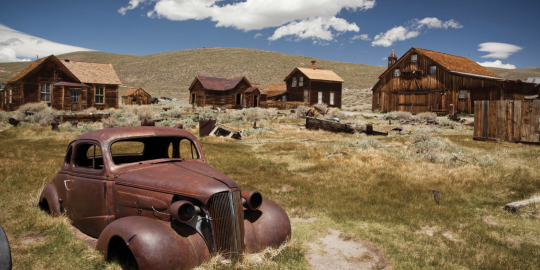
Bodie, California
Bodi is a ghost town in the Bodie Hills east of the Sierra Nevada mountain range in Mono County, California, United States. It is about 75 miles (121 km) southeast of Lake Tahoe, and 12 mi (19 km) east-southeast of Bridgeport, at an elevation of 8,379 feet (2554 m). Bodie became a boom town in 1876 (147 years ago) after the discovery of a profitable vein of gold; by 1879 it had established 2,000 structures with a population of roughly 8,000 people. The town went into decline in the subsequent decades and came to be described as a ghost town by 1915 (108 years ago). The U.S. Department of the Interior recognizes the designated Bodie Historic District as a National Historic Landmark. Also registered as a California Historical Landmark, the ghost town officially was established as Bodie State Historic Park in 1962. It receives about 200,000 visitors yearly. Bodie State Historic Park is partly supported by the Bodie Foundation.
Read more
#bodie#ghost town#abandoned#california#wikipedia#weird facts#weird history#strange facts#strange history#random fact#weird wikipedia#wikiweird#history
25 notes
·
View notes
Text
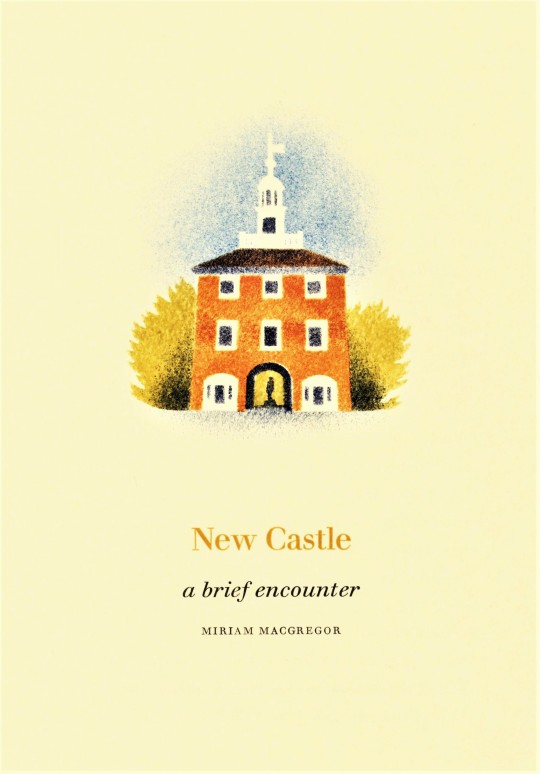






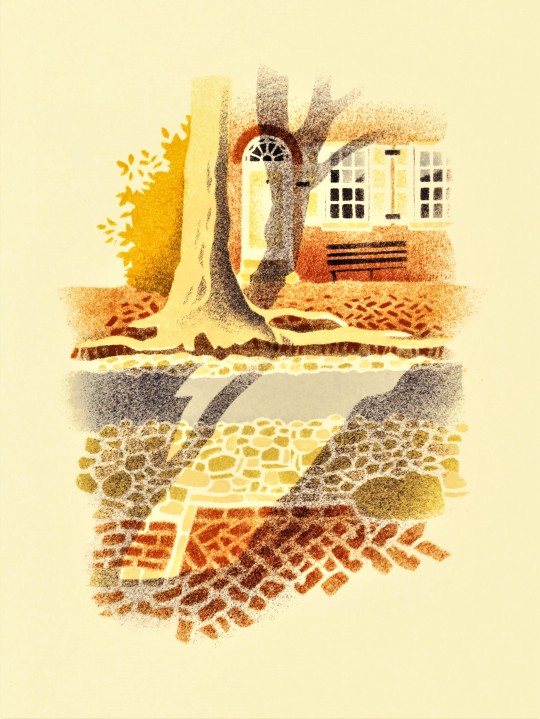


It's Fine Press Friday!
The recent donation from the estate of Dennis Bayuzick includes several publications by the British Whittington Press, a few of which are illustrated using the pochoir stencil technique, including the book New Castle, a brief encounter by longtime Whittington illustrator and compositor Miriam Macgregor. The book, printed in 1998 in hand-set 14 pt. Walbaum type on Zerkall mould-made paper in an edition of 100 copies signed by the author/artist, is Macgregor's memoir of her visit to the Historic District of New Castle, Delaware, where she had gone to visit Oak Knoll Books, one of America's premier bookstores specializing in fine press publications and books on books. We think the occasion was for the 1997 Oak Knoll Fest.
New Castle's Historic District, designated a National Historic Landmark in 1967, contains about 500 historic buildings from the colonial and early Republic periods, one of the highest concentrations of well-preserved buildings from this period. At the time, Oak Knoll was located in a later-period building that used to be the town's butcher shop, just a block and a half north of the Historic District's town square, "The Green." Macgregor writes:
This small town on the western bank of the Delaware River was an enchanting, if misleading, introduction to America, and the following images are the result of one day's drawing, some photographs and, of course, memory.
Once a busy little port town but long since diminished, Macgregor notes that:
A 1932 guidebook described it as 'a diminutive town of forgotten asperations, the beckoning path of Europe spread before its sleepy eyes.' Thus, away from the limelight, many of the older buildings escaped modernisation and in due course, the inhabitants came to realise that they had a living museum to hand -- a microcosm of American colonial architecture.
View more posts that include the work of Miriam Macgregor.
View other posts relating to the Whittington Press.
View other examples of pochoir illustration.
View other books from the collection of Dennis Bayuzick.
View more Fine Press Friday Posts.
#Fine Press Friday#fine press fridays#fine press printing#fine press books#fine press publishing#pochoir#Miriam Macgregor#whittington press#New Castle a brief encounter#New Castle Delaware#Walbaum type#Zerkall paper#Oak Knoll#Dennis Bayuzick
47 notes
·
View notes
Text


At the nexus of most of America’s current crises, the diversity/equity/inclusion dogma can be found.
The southern border has been destroyed because the Democratic Party wanted the poor of the southern hemisphere to be counted in the census, to vote if possible in poorly audited mail-in elections, and to build upon constituencies that demand government help. Opposition to such cynicism and the de facto destruction of enforcement of U.S. immigration law is written off as “racism,” “nativism,” and “xenophobia.”
The military is short more than 40,000 soldiers. The Pentagon may fault youth gangs, drug use, or a tight labor market. But the real shortfall is mostly due inordinately to reluctant white males who have been smeared by some of the military elite as suspected “white supremacists,” despite dying at twice their demographics in Iraq and Afghanistan. And they are now passing on joining up despite their families’ often multigenerational combat service.
The nexus between critical race theory and critical legal theory has been, inter alia, defunding the police, Soros-funded district attorneys exempting criminals from punishment, the legitimization of mass looting, squatters’ rights, and general lawlessness across big-city America.
The recent epidemic of anti-Semitism was in part birthed by woke/DEI faculty and students on elite campuses, who declared Hamas a victim of “white settler” victimizing Israel and thus contextualized their Jewish hatred by claiming that as “victims,” they cannot be bigots.
There is a historic, malevolent role of states adjudicating political purity, substituting racial, sex, class, and tribal criteria for meritocracy. They define success or failure not based on actual outcomes but on the degree of orthodox zealotry. Once governments enter that realm of the surreal, the result is always an utter disaster.
After a series of disastrous military catastrophes in 1941 and 1942, Soviet strongman and arch-communist Joseph Stalin ended the Soviet commissar system in October 1942. He reversed course to give absolute tactical authority to his ground commanders rather than to the communist overseers, as was customary.
Stalin really had no choice since Marxist-Leninist ideology overriding military logic and efficacy had ensured that the Soviet Union was surprised by a massive Nazi invasion in June 1941. The Russians in the first 12 months of war subsequently lost nearly 5 million in vast encirclements—largely because foolhardy, ideologically driven directives curtailed the generals’ operational control of the army. After the commissars were disbanded and commanders given greater autonomy, the landmark victory at Stalingrad followed, and with it, the rebound of the Red Army.
One reason why the dictator Napoleon ran wild in Europe for nearly 18 years was that his marshals of France were neither selected only by the old Bourbon standards of aristocratic birth and wealth nor by new ideological revolutionary criteria, but by more meritocratic means than those of his rival nations.
Mao’s decade-long cultural revolution (1966–76) ruined China. It was predicated on Maoist revolutionary dogma overruling economic, social, cultural, and military realities. An entire meritocracy was deemed corrupted by the West and reactionary—and thus either liquidated or rendered inert.
In their place, incompetent zealots competed to destroy all prior standards as “bourgeois” and “counter-revolutionary.” It is no surprise that the current “people’s liberation army,” for all its talk of communist dogma, does not function entirely on Mao’s principles.
Muammar Gaddafi wrecked Libya by reordering an once oil-rich nation on Gaddafi’s crackpot rules of his “Green Book.” At times, the unhinged ideologue, in lunatic fashion, required all Libyans to raise chickens or to destroy all the violins in the nation. I once asked a Libyan why the oil-rich country appeared to me utterly wrecked, and he answered, “We first hire our first cousins—and usually the worst.”
There were many reasons why the King-Cotton, slave-owning Old South lagged far behind the North in population, productivity, and infrastructure. But the chief factor was the capital and effort invested in the amoral as well as uneconomic institution of slavery.
After the Civil War, persistent segregationist ideology demanded vast amounts of time, labor, and money in defining race down to the “one drop” rule—while establishing a labyrinth of segregation laws and refusing to draw on the talents of millions of black citizens.
Yet here we are in 2024, ignoring the baleful past as the woke diversity/equity/inclusion commissars war on merit. Institutions from United Airlines and the Federal Aviation Administration to the Pentagon and elite universities have been reformulated in the post-George Floyd woke hysteria. And to the delight of competitors and enemies abroad, they are now using criteria other than merit to hire, promote, evaluate, and retain.
The greatest problem historically with hiring and promoting based on DEI-like dogma is that anti-meritocratic criteria mark the beginning, not the end, of eroding vital standards. If one does not qualify for a position or slot by accepted standards, then a series of further remedial interventions are needed to sustain the woke project, from providing exceptions and exemptions, changing rules and requirements, and misleading the nation that a more “diverse” math, or more “inclusive” engineering, or more “equity” in chemistry can supplant mastery of critical knowledge that transcends gender, race, or ideology.
But planes either fly or crash due to proper operation, not the appearance or politics of the operator. All soldiers either hit or miss targets, and engineers either make bridges that stand or collapse on the basis of mastering ancient scientific canons and acquired skills, training, and aptitude that have nothing to do with superficial appearance, or tribal affinities, or religion, or doctrine.
The common denominator of critical theories, from critical legal theory to critical social theory, is toxic nihilism, which claims there are no absolute standards, only arbitrary rules and regulations set up by a privileged, powerful class to exploit “the other.” Yet, not punishing looting has nothing to do with race or class, but everything with corroding timeless deterrence that always has and always will prevent the bullying strong from preying on the weak and vulnerable.
Defunding the police sent a message to any criminally minded that in a cost-to-benefit risk assessment, the odds were now on the side of the criminal not being caught for his crimes—and so crime soared and the vulnerable of the inner city became easy prey.
Another danger of DEI is the subordination of the individual to the collective. We are currently witnessing an epidemic of DEI racism in which commissars talk nonstop of white supremacy/rage/privilege without any notion of enormous differences among 230 million individual Polish-, Greek-, Dutch-, Basque-, or Armenian-Americans, or the class, political, and cultural abyss that separates those in Martha’s Vineyard from their antitheses in East Palestine, Ohio.
Moreover, what is “whiteness” in an increasingly intermarried and multiracial society? Oddly, something akin to the old one-drop rules of the South is now updated to determine victims and victimizers—to the point of absurdity. Who is white—someone one half-Irish, one half Mexican—who is black—someone one quarter Jamaican, three-quarters German? To find answers, DEI czars must look to paradigms of the racist past for answers.
Moreover, once any group is exempted and not held to collective standards by virtue of its superficial appearance, then the nation naturally witnesses an increase in racism and bigotry—on the theory that it is not racist to racially stigmatize a supposedly “racist” collective. And we are already seeing an uptake in racially motivated interracial violence as criminals interpret the trickle-down theory of reparatory justice as providing exemption for opportunistic violence.
Throughout history, it has always been the most mediocre and opportunistic would-be commissars that appear to come forth when meritocracy vanishes. If there was not a Harvard President and plagiarist like Claudine Gay to trumpet and leverage her DEI credentials, she would have to be invented. If there was not a brilliant, non-DEI economist like Roland Fryer to be hounded and punished by her, he would have to be invented.
The DEI conglomerate has little idea of the landmines it is planting daily by reducing differences in talent, character, and morality into a boring blueprint of racial stereotypes. Punctuality is now “white time” and supposedly pernicious. The SAT, designed to give the less privileged a meritocratic pathway to college admissions, is deemed racist and either discarded or warped.
In its absence, universities are quietly now “reimaging” their curriculum to make it more “relevant to today’s students” and, of course, “more inclusive and more diverse.” Translated from the language of Oceania, that means after admitting tens of thousands to the nation’s elite schools who did not meet the universities’ own prior standards that they themselves once established and apprehensive about terminating such students, higher education is now euphemistically lowering the work load in classes, introducing new less rigorous classes, and inflating grades. In their virtue-signaling, they have little clue that inevitably their once prized and supposedly prestigious degrees will be rendered less valued as employers discover a Harvard, Stanford, or Princeton BA or BS is not a guarantee of academic excellence or mastery of vital skill sets.
Toxic tribalism is also, unfortunately, like nuclear proliferation. Once one group goes full tribal, others may as well, if for no reason than their own self-survival in a balkanized, Hobbesian world of bellum omnium contra omnes. If our popular culture is to be defined by the racist hosts of The View, or the racist anchorwoman Joy Reid, or members of the Congressman “Squad,” or entire studies departments in our universities that constantly bleat out the racialist mantra, then logically one of two developments will follow.
One, so-called whites in minority-majority states like California will copy the tribal affinities of others that transcend their class and cultural differences, again in response to other blocs that do the same for careerist advantage and perceived survival. Or two, racism will be redefined empirically so that any careerist elites who espouse ad nauseam racial chauvinism—on the assurance they cannot be deemed racists—will be discredited and exposed for what they’ve become, and thus the content of our character will triumph over the color of our skin.
Finally, do we ever ask how a country of immigrants like the United States—vastly smaller than India and China, less materially rich than the vast expanse of Russia, without the strategic geography of the Middle East, or without the long investment and infrastructure of Europe—emerged out of nowhere to dominate the world economically, financially, militarily, and educationally for nearly two centuries?
The answer is easy: it was the most meritocratic land of opportunity in the world, where millions emigrated (legally) on the assurance that their class, politics, religion, ethnicity, and yes, race, would be far less a drawback than anywhere else in the world.
The degree to which the U.S. survives DEI depends on either how quickly it is discarded or whether America’s existential enemies in the Middle East, China, Russia, and Iran have even worse DEI-anti-meritocratic criteria of their own in hiring, promotion, and admissions—whether defined by institutionalized hatred of the West, or loyalty oaths to the communist party, or demonstrable obsequiousness to the Putin regime, or lethal religious intolerance.
Unfortunately, our illiberal enemies, China especially, at least in matters of money and arms, are now emulating the meritocracy of the old America. Meanwhile, we are hellbent on following their former destructive habits of using politics instead of merit to staff our universities, government, corporations, and military.
Our future hinges on how quickly we discard DEI orthodoxy and simply make empirical decisions to stop printing money, deter enemies abroad, enforce our laws, punish criminals, secure the border, reboot the military, regain energy independence, and judge citizens on their character and talent and not their appearance and politics—at least if it is not already too late.
6 notes
·
View notes
Text






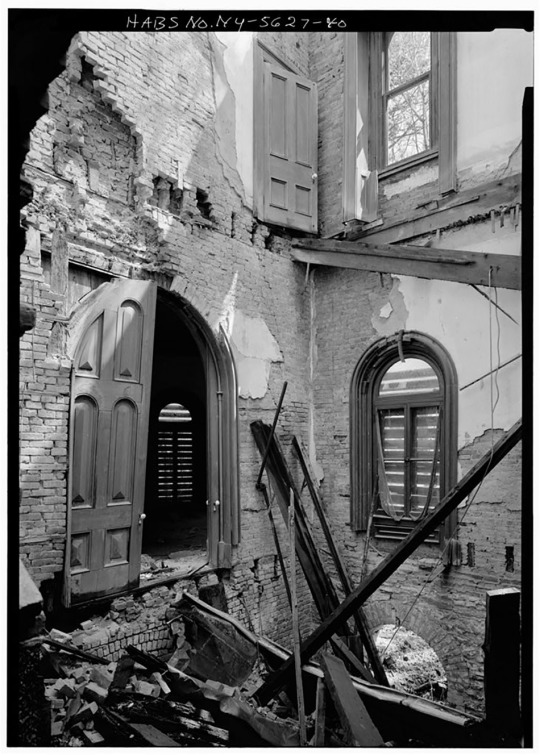

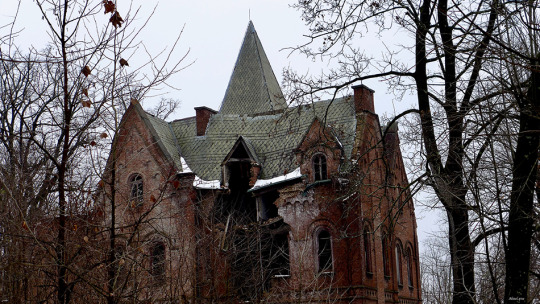
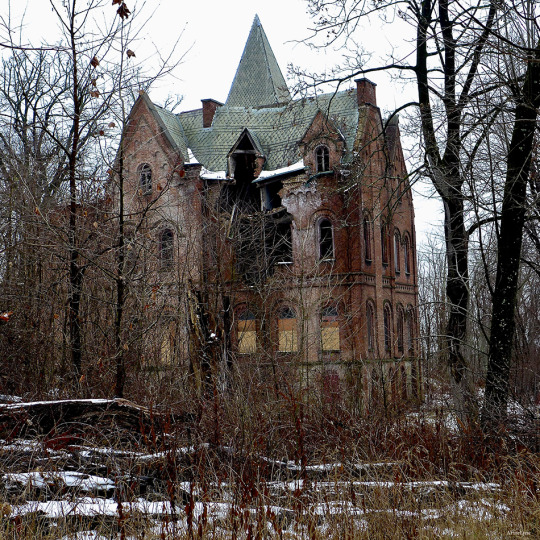
Wyndclyffe Mansion
Located at 25 Wynclyffe Court, a private road off Mill Road, in Rhinebeck, New York, Wyndclyffe is in a National Historic Landmark District. Built in 1853 and abandoned since 1950. This place is thought to have inspired the term "Keeping up with the Joneses".
This mansion was purchased by the wealthy socialite Elizabeth Jones in 1853 as a summer house. A cousin to the Astors and aunt to Edith Wharton, Jones occupied a space in the upper echelons of New York high society. In 1853 she had built for herself this gothic mansion in the sleepy hamlet of Rhinecliff, a hundred miles up the Hudson River. The mansion was eluded to in both of Wharton's novels, “A Backward Glance” and “Hudson River Bracketed.”
The 24 bedroom gothic mansion had towers and gables and arched windows. It was so grand that it prompted a ‘building boom’ as all neighbors started upgrading their houses, and the saying “Keeping up with the Joneses” was born.
Elizabeth Jones never married, and after her death, the mansion’s later owners fell foul of the Great Depression, until in 1950, the house was abandoned for good.
Update ~ May, 2023: Town Board members have approved the stabilization plan for the Wyndclyffe mansion in an effort to move forward with the restoration of the 170-year-old deteriorating relic of pre-Civil War extravagance.
#Wyndclyffe#Elizabeth Jones#keeping up with the joneses#black and white photography#vintage photography#historic#historic landmark#historical architecture#american gothic#gothic#new york#abandoned homes#abandoned#empty spaces#ghosts of years gone by#edith wharton#the Astors#grand mansion#pre-civil war#1853#1850s#history#historic preservation
10 notes
·
View notes
Text
A Journey to Remember: Exploring Cape Town's Wonders

Introduction:
Cape Town, a city where the mountains meet the sea, is a destination that captivates travellers from around the world with its natural beauty, rich history, and vibrant culture. From the iconic Table Mountain to the scenic Cape Winelands, there's no shortage of attractions and experiences waiting to be discovered in this South African gem. If you're planning a Tour to Cape Town, get ready for the adventure of a lifetime as we dive into the wonders that await you in the Mother City and its surrounding regions.
Table Mountain:
No visit to Cape Town is complete without a trip to Table Mountain, one of the New Seven Wonders of Nature. Whether you choose to hike to the summit or take the rotating cable car, the panoramic views of the city, coastline, and surrounding landscapes are simply breathtaking. Be sure to visit at sunrise or sunset for an unforgettable experience and don't forget your camera to capture the stunning vistas.
Cape Peninsula:
Embark on a journey along the scenic Cape Peninsula, where rugged cliffs, pristine beaches, and charming coastal towns await. Drive along the breathtaking Chapman's Peak Drive, explore the Cape Point Nature Reserve, and visit the adorable African penguins at Boulders Beach. Don't miss the opportunity to take a dip in the refreshing waters of the Atlantic Ocean at one of the peninsula's many beautiful beaches.
Robben Island:
Delve into South Africa's rich history with a visit to Robben Island, a UNESCO World Heritage Site and former political prison. Take a ferry from the V&A Waterfront to the island and tour the prison complex, where Nelson Mandela and other anti-apartheid activists were once incarcerated. Hear firsthand accounts from former political prisoners and gain insight into the country's struggle for freedom and democracy.
Cape Winelands:
Indulge your senses with a day trip to the Cape Winelands, where lush vineyards, historic estates, and award-winning wines await. Explore charming towns such as Stellenbosch, Franschhoek, and Paarl, and sample a variety of wines and gourmet cuisine at some of the region's finest wineries. Don't forget to savour the stunning scenery of rolling hills and mountain ranges that make the Cape Winelands a feast for the eyes as well as the palate.
Kirstenbosch Botanical Gardens:
Escape the hustle and bustle of the city and immerse yourself in the tranquillity of Kirstenbosch National Botanical Garden. Located at the foot of Table Mountain, Kirstenbosch boasts an impressive collection of indigenous plants, including rare and endangered species. Take a stroll along winding paths, discover unique garden sculptures, and enjoy a picnic amidst the breathtaking natural surroundings.
Township Tour:
Gain insight into Cape Town's diverse cultural landscape with a township tour, where you'll have the opportunity to visit vibrant communities such as Langa, Khayelitsha, or Imizamo Yethu. Meet with residents, learn about their traditions and customs, and support local businesses as you explore the streets, markets, and cultural centres of these dynamic neighbourhoods.
Cape Town City Tour:
Discover the rich history, vibrant culture, and iconic landmarks of Cape Town on a city tour. Visit historic sites such as the Company's Garden, Castle of Good Hope, and District Six Museum, and explore the colorful streets of Bo-Kaap with its distinctive Cape Malay architecture. Whether you're wandering through bustling markets or admiring street art in the city's vibrant neighbourhoods, there's always something new and exciting to discover in Cape Town.

Conclusion:
Cape Town Tours Packages promises an unforgettable journey filled with breathtaking scenery, rich history, and vibrant culture. Whether you're hiking to the summit of Table Mountain, exploring the charming coastal towns of the Cape Peninsula, or indulging in wine tasting in the Cape Winelands, the experiences that await you in the Mother City are sure to leave a lasting impression. So pack your bags, lace up your hiking boots, and get ready for the adventure of a lifetime in Cape Town, South Africa.
3 notes
·
View notes
Photo




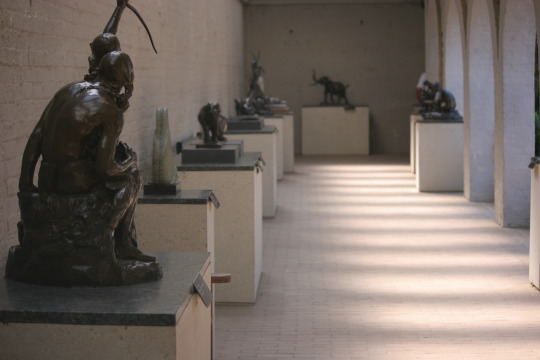





[ Atalaya & Brookgreen Gardens, Murrell’s Inlet, South Carolina — September 2022 ]
Atalaya and Brookgreen Gardens is a National Historic Landmark District encompassing two formerly-united properties associated with sculptor Anna Hyatt Huntington. It includes the nation's first formal sculpture garden, and one of the studios at which Huntington did her most productive work.
#so atalaya is actually not all that impressive - they clearly did not keep it up after anna left in the 1950s#but it DOES give the very clear impression of being very haunted.#it's all the faded whitewashing and the uneven floors and the occasional cupboard or tap left behind#brookgreen is way more fun; it's not just devoted to anna's sculptures anymore; it's a hodgepodge of different modern sculptors#in fact the national sculpture society finalists were on display when we went which was a cool way of showing the continuity#of people making figurative sculptures#.......also I'm pretty convinced that anna and archer huntington had a lavender marriage though I have no proof of it#except reading between the lines of some faded historical plaques#wherever there is light#the lesser american roadtrip
45 notes
·
View notes
Text

Located at the southern end of Coronado Beach on San Diego County’s Coronado Island, Hotel del Coronado opened in 1888.
The legendary beach resort is split into five elegant districts, ranging from the original storybook Victorian section of the resort to modern condo residences and a gated beachfront community of cottages and villas.
Designated a National Historic Landmark in 1977, the grandiose hotel appeared in the classic 1958 film Some Like it Hot starring Marilyn Monroe, and it hosted President Richard Nixon’s state dinner in 1970.
Today, guests can experience a variety of upscale amenities, from cooking s’mores on a private bonfire to boat rentals or surf classes with a professional Hawaiian surfer.
Used as the "inspiration" for Disney's Grand Floridian at the Magic Kingdom in Orlando, Florida...
3 notes
·
View notes
Text
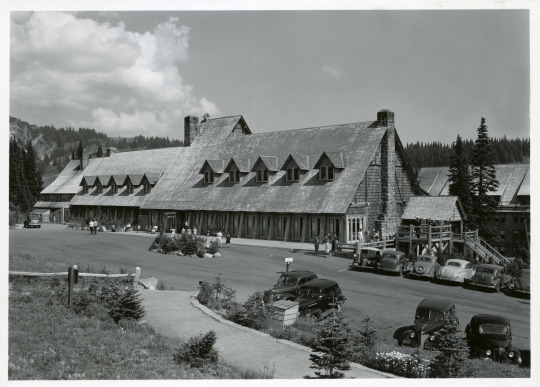

Mount Rainier National Park Archives Photos of the Paradise Inn exterior in 1940-41 (top) and NPS Photo of the Paradise Inn in 2018.
The Paradise Inn was built in 1917 by the Rainier National Park Company concessionaire. While built of wood and stone similar to other NPS rustic-style buildings found in the park, the Paradise Inn is more “whimsical” in design and meant to be reminiscent of European alpine resort architecture. The Paradise Inn is part of the Mount Rainier National Historic Landmark District but is also independently designated a National Historic Landmark for its architectural style.
One of the popular features of the Paradise Inn are the lanterns in the lobby painted with wildflowers. When the inn first opened, it had Japanese lanterns in the lobby, as seen in this 1919 photo of the interior:

Mount Rainier National Park Archives Photos of the Paradise Inn interior in 1919 with Japanese lanterns.
The first lampshades featuring wildflowers were added in the 1930s, mostly painted by the wives of rangers at the time, and the current lampshades were painted by retired Chief Naturalist Dale Thompson in 1989.

NPS Photo of wildflower lanterns inside the Paradise Inn, 2018.
Have you visited the Paradise Inn during the summer and viewed the wildflower lanterns in the lobby?
#Mount Rainier History#mount rainier national park#Paradise Inn#Paradise#history#architecture#national historic landmark#national historic landmark district
54 notes
·
View notes
Text

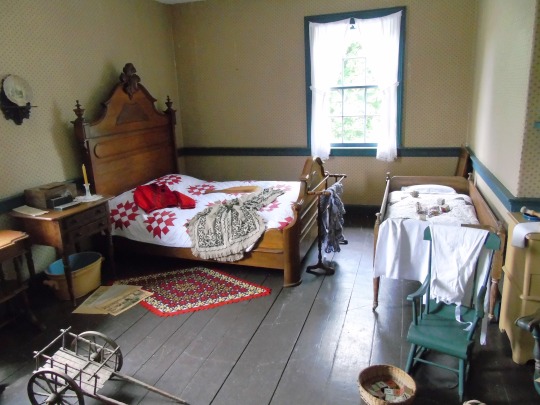




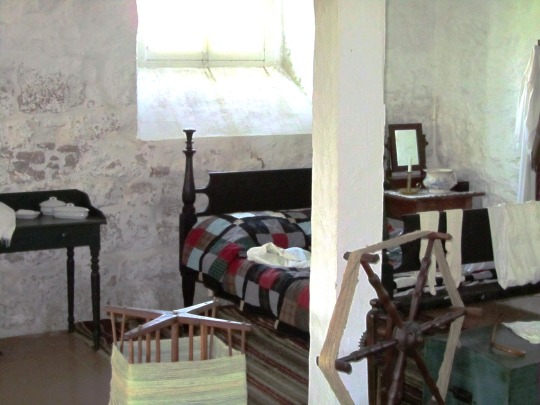





National Quilting Day
A quilt is a type of bed cover, traditionally composed of three layers of fiber, a woven cloth top, a layer of batting or wadding, and a woven back, combined using the technique of quilting. A quilt is distinguishable from other types of blankets because it is pieced together with several pieces of cloth.
National Quilting Day recognizes quiltmakers and their quilt-making abilities. The word ‘quilt’ comes from the Latin word ‘culcita,’ which means stuffed sack, it became adapted to the English language from the French word ‘cuilte.’
Quilting practices can be found in almost every area of the world and it is celebrated on the third Saturday in March every year. The National Quilting Association started National Quilting Day in 1991 and since then it has grown into a global celebration for all quilt lovers and makers.
History of National Quilting Day
Quilting refers to the technique of joining at least two fabric layers by stitches or ties. The quilting practice dates back as far as 3400 B.C. It was mainly a practical technique that provided physical protection and insulation. However, decorative elements were often also present and many quilts are now primarily art pieces.
In the United States, quiltmaking was common in the late 17th century and early years of the 18th century. In these times, only the wealthy had the time to practice quilting so it was done by only a few persons. Commercial blankets or woven coverlets were a more economical bed covering for most people unlike the colonial quilt bed covering which displayed the fine needlework of the maker, such as the Baltimore album quilts. Presently, quilting is now a popular hobby, with an estimated base of twenty-one million quilters.
The oldest example of a quilted piece is kept at the Saint Petersburg department of the Russian Academy of Sciences, Archaeology section. It is a linen carpet that was found in a Mongolian cave, between 100 B.C. and 200 A.D.
The origin of the quilting day can be traced to the Quilters Day Out, which was organized by the Kentucky Heritage Quilt Society in 1989 to celebrate the ancient tradition and its practice in the state of Kentucky. Two years later, this event became so popular that the National Quilting Association decided to declare an official holiday for quilting. From this day, the name changed from Quilters Day Out to National Quilting Day. Over the years, this event has attracted people to celebrate from all over the world and participate in helping to build and maintain the global heritage of quilting.
The first remnants of quilting were dated to 3400 B.C., showing that this art form had existed far into pre-history. They were traded extensively until sometime in the 12th century when these types of trade goods were returned from the Middle East by the Crusaders. Since then, it had become an integral part of the Colonial textile arts and one of the things they were well known for.
National Quilting Day timeline
1170 — 1800
The Birth of Pieced and Applique Quilts
During American Colonial times, quilts are known to be predominantly whole cloth quilts. Later on, pieced and applique quilts begin to appear.
1989
The Roots of Quilting Day
Quilters Day Out is first organized by the Kentucky Heritage Quilting Association in 1989, which later leads to the birth of National Quilting Day.
1991
The Dawn of National Quilting Day
In June, members of the National Quilting Association pass a resolution in Lincoln, Nebraska, for the celebration of National Quilting Day.
2001
Commemoration of the Demise
The National Quilt Museum is honored to host a collection of quilts from the 9/11 Memorial and Museum for the commemoration of the 20th anniversary of the September 11 attacks.
National Quilting Day FAQs
When do people celebrate National Quilting Day?
National Quilting Day is celebrated on the third Saturday in March annually.
What month is National Quilting Month?
National Quilting Month is celebrated during the month of March.
What are the types of quilts?
There are three types of quilts, namely patchwork quilts, applique quilts, and embroidered quilts.
How to Celebrate National Quilting Day
Hang quilts outdoors: On National Quilting Day, quilts are hung outside the homes to educate and inspire people to join in celebrating this ancient creative skill and as a sign that you recognize this event and that you are observing it.
Show your quilting skills: This holiday is a time to share your skills with others by offering to teach a simple quilt project A.M.D. showing them how it’s done. You can decide to teach this to your relatives/family members, schools, neighbors, friends, or a youth group.
Make it a service day: On this day, you can work on a quilt for your favorite cause — either national or local projects. You can also check departments and facilities like the police and fire departments, nursing facilities, or children’s services to see if they have a need for quilts.
5 Fascinating Facts About Quilting
The origin of the word: The word ‘quilt’ comes from the Latin word ‘culcita’, meaning a stuffed sack.
There is an identity behind a quilt: It would interest you to know that quiltmakers make the quilts in such a way that depicts the quality of their lives or custom. Think of it as a book of tradition where pieces of stories are sewed together.
A precious heritage: Apart from the professional quiltmakers, women of the old generation can make a traditional quilt and it is passed down from one generation to the other; from grandmother to mother and mother to daughter.
For armor protection: Medieval knights used quilted pads under their armors, to protect them from chaffing and to prevent the armor from rusting from sweat.
Interest for the husband: During the 19th century, it was customary for a woman to show her quilting skills to her new husband.
Why We Love National Quilting Day
It’s a day for fun: It is a day to share in the fun and appreciate the history of quilts; to share quilting stories, fabrics, and patterns.
It’s a time to reflect on the old times: Quilting is a practice that can be dated as far back as 3400 B.C. Quilting day allows us to appreciate this old-time art, understand the history, and value it, like a connection between the past and present, creativity and heritage.
It’s a day to understand its symbolism: Quilts often symbolize resourcefulness, as quilters use what resources are available to them to make a quilt covering. They also symbolize heritage.
#log cabin#Kings Landing Historical Settlement#New Brunswick#Canada#summer 2015#2012#original photography#tourist attraction#landmark#Lower Fort Garry National Historic Site of Canada#Manitoba#El Pueblo de Los Angeles Historical Monument#Los Angeles Plaza Historic District#Avila Adobe#National Quilting Day#NationalQuiltingDay#16 March 2024#third Saturday in March#Pennsylvania#2009#Amish Country#Lancaster County#British Columbia#travel#vacation#USA#architecture#Los Angeles
3 notes
·
View notes
Text
Best Places You Must Visit in Tokyo
Introduction:
Explore japan tourist places in Tokyo, which is a very interesting combination of tradition and also modernity. Admire the famous Tokyo Tower, take a walk through the historical Asakusa district, visit the lively Shibuya Crossing, taste the delicious sushi at Tsukiji Fish Market, and relax in the peaceful Meiji Shrine. Diverse wonders for every traveler await in Tokyo.
Tokyo's Towering Beauty: The symbol of the city, the Tokyo Tower is a very tall standing building with its orange and white exterior. Climb to get the panoramic views of the city’s sprawling skyline where modernity sits with tradition and a visual feast of lights and landmarks for the eyes.
Historical Charm of Kyoto: The city of Kyoto, also a capsule of Japan’s past, has many ancient temples such as Kinkaku-ji and peaceful tea houses in areas such as Gion. Walk along the streets of history where the traditional wooden machiya houses take you back to the nostalgia of the old times.
Natural Serenity in Hakone: Hakone, a serene haven, beckons you to unwind in its revitalizing hot springs, under the watchful eye of Mount Fuji. The untouched nature, including dense forests, and quiet lakes, only adds to the tranquil ambiance, making it a very perfect getaway.
Osaka's Culinary Delights: Osaka, a foodie’s dream, comes with an exciting street food culture. From savory takoyaki to the crispy okonomiyaki, savor the local treats. Discover the famous markets such as Kuromon Ichiba, where the smell of different tastes permeates the air, a culinary tour for every tongue.
Hiroshima's Peaceful Memorial: There is a memorial park in Hiroshima, a place of remembrance that honors the past. The Atomic Bomb Dome is a symbol of the city’s history. As you walk through the park and its peaceful environment, meditate on the messages of peace and resilience to encourage reflection and comprehension.
Snowy Adventure in Sapporo: Sapporo turns into a winter fairytale, mesmerizing tourists with its famous snow festivals and ski slopes. Enjoy the wonders of the snow sculptures, sample the local food at the Sapporo Snow Festival, and ski or snowboard in the beautiful Hokkaido scenery.
Nagasaki's Rich Maritime History: Dejima Island, a former trading outpost, showcases the maritime legacy of Nagasaki. Visit the old Dutch trading post that has been preserved and learn about Nagasaki in its maritime history. The Peace Memorial deepens the meaning, considering Nagasaki’s strength and dedication to peace after the atomic bombing.
Majestic Landscapes of Nikko: Nikko promises a grandiose landscape, home to UNESCO World Heritage sites such as the Toshogu Shrine. Admire the beautiful structures and peaceful scenery. Discover Nikko’s natural landscape, including the majestic waterfalls, where the spiritual and natural elements combine to form a mystical environment in this timeless and idyllic locale.
Conclusion:
Japan presents a collage of experiences, ranging from the high-tech marvels of Akihabara to the tranquillity of the Nikko. Indeed, as the Diper Tour brings the Filipinos closer to these wonders, Japan’s charm becomes more obtainable. Celebrate the cultural convergence in the Japan tourists spots from Philippines, which serves as a great bridge between nations that share similar wonders and also memories.
#Japan tourists spots from Philippines#places to visit in Japan#Japan travel#Japan tourism#Japan tourists spots#visit Japan#holidays to Japan#Japan itinerary#Japan trip#Osaka itinerary#Tokyo itinerary
2 notes
·
View notes
Text

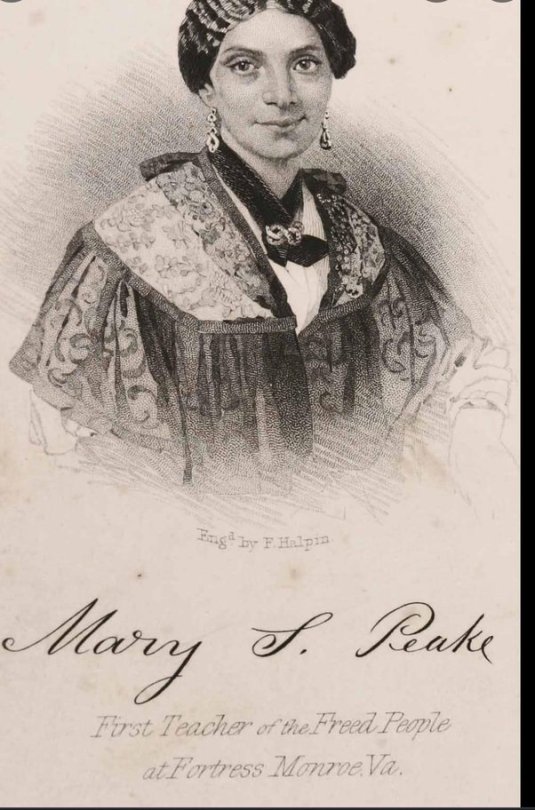

Mary Smith Peake, born Mary Smith Kelsey (1823 – February 22, 1862), was an American teacher, humanitarian and a member of the African elite in Hampton, best known for starting a school for the children of former slaves starting in the fall of 1861 under what became known as the Emancipation Oak tree in present-day Hampton, Virginia near Fort Monroe. The first teacher hired by the American Missionary Association, she was also associated with its later founding of Hampton University in 1868.
Mary Smith Kelsey was born free in Norfolk, Virginia. Her father was an Englishman "of rank and culture" and her mother was a free woman of color. When Mary was six, her mother sent her to Alexandria (then part of the District of Columbia) to attend school. Living with her aunt Mary Paine, Kelsey studied for about ten years.
The US Congress enacted a law prohibiting free people of color in the District of Columbia from being educated (as was the case in Virginia and several other southern states). (This was several years before Alexandria was retroceded to Virginia in 1846.) The new law closed all schools for free Africans in that city, as had happened in Virginia after the Nat Turner Rebellion of http://1831.In 1839, at age sixteen Mary Kelsey returned to live with her mother. Despite the risk, she secretly taught slaves and free Africans to read and write, which was prohibited by law. She believed education was important to the race.
In 1847 her mother married Thompson Walker and the family moved to Hampton, where they bought a house. In the 1850s she secretly began teaching enslaved and free African Americans and she was one of a number of black women whose teaching was, a few years later, officially sanctioned by the Union army as the United States entered the Civil War.
There Kelsey founded a women's charitable organization, called the Daughters of Zion, whose mission was to assist the poor and the sick. She supported herself chiefly by dressmaking and continued to teach in secret. Among her adult students was her stepfather Thompson Walker, who even more became a leader of the Africans in Hampton. In 1851 Kelsey married Thomas Peake, a freed slave who worked in the merchant marine.
They had a daughter named Hattie, whom they nicknamed "Daisy".During the American Civil War (1861–1865), Union forces maintained control of nearby Fort Monroe, which became a place of refuge for escaped slaves' seeking asylum. The Union defined them as "contraband", a legal status to prevent their being returned to Confederate slaveholders. They built the Grand Contraband Camp near but outside the protection of Fort Monroe.
Mary Peake started teaching the children of former slaves and the American Missionary Association (AMA) paid her some salary and gave support as its first African teacher. She began teaching outside on September 17, 1861 under a large oak tree in Phoebus, a small town nearby in Elizabeth City County. In 1863, the Virginia Peninsula community gathered under this tree to hear the first Southern reading of President Abraham Lincoln's Emancipation Proclamation, and it became known as the Emancipation Oak.
Soon the AMA provided Peake with Brown Cottage, long considered the first facility of Hampton Institute (and later Hampton University). Both children and adults were eager to learn: Mary Peake's school taught more than fifty children during the day and twenty adults at night.
Although seriously ill, Peake continued teaching. On Washington's birthday, February 22, 1862, Peake died of tuberculosis, which she had contracted before the war.
The historic Emancipation Oak still stands near the entrance to the campus of Hampton University in what is now the City of Hampton. It is designated a National Historic Landmark by the Department of the Interior and one of the 10 Great Trees of the World by the National Geographic Society.
#african#kemetic dreams#mary smith kelsey#afrakan#brownskin#afrakans#africans#brown skin#peake#hampton#virginia#abraham lincoln
21 notes
·
View notes
Text
World Tell-All Tuesday: Maps
I made a map for The Protolith a little while ago, so I thought I introduce some of the locations:
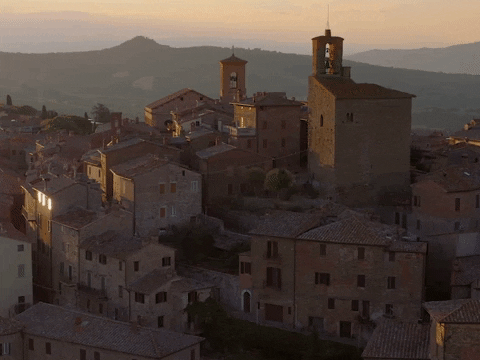
The Empire controlled its own continent, but across the oceans were two more major powers: the Southeast States, a collection of loosely organized governments in the Southern tundra, and the Western Kingdom, a peaceful nation northwest of the Empire.
[The map is not entirely consistent with the text. Don't come for me]
***
The Empire
An theocratic, oligarchic state governed by an Emperor, his High Court, and the Church. After Emperor Ambrose the First's assassination, the Empire has entered an era of instability. Currently, the Empress Mother and the Child Emperor rule. The Empire has a temperature climate with regions of mountains and plains.
There are three important cities in the Empire:
Lorenzia
Our main setting Lorenzia is the capital city of the Empire. Lorenzia is a mountainous, coastal city. The city has several neighborhoods including the docks, downtown, center city, the university district, the marketplace district, and uptown.
Key landmarks include the bathhouse, built into the side of a mountain by center city, and the Lorenzian temple, a strange building in the plains north of the city.
Lorenzia is known for its modern and indulgent sexual attitudes despite the strong church presence.
Astriel
A pious city north of Lorenzia
“I’ve been so recently fascinated by the culture wars here in Lorenzia,” Nathaniel explained. “Your Worship, I hail from Astriel.”
“A Godly city, of course.”
“So you understand! Lorenzia is such a city of contradictions. Historically, the church made many allowances to placate the local culture and that has lived on for centuries. But – as you surely know – the church has recently supported new regulation. It’s quite the departure.” Nathaniel shrugged but his eyes were lit from within.
Harcross
A rural town near the Southern border
There was an inn which sat along a well established path for travelers coming up from the southern Empire toward the cities, Harcross or Lorenzia. Three women ran this inn: Darcy, Clara, and Josephine. Like any mortal, they’d been born somewhere else, found each other, and set up shop in an old building, but it felt like they’d always been there – like they’d sprung up from the earth, fully formed with this inn around them.
The Western Kingdom
A tropical nation north of the Empire. A pacifist nation, the Western Kingdoms resisted advances from the Empire for centuries using only defensive tactics. This kingdom is known for its colorful flora, dangerous fauna, and its illustrious silk.
“Commander Noble? You may have heard of him. Single-handedly, he opened trade with the Western Kingdom.”
The Southeast States
A conglomeration of states run by a weak central power and fueled by serfdom, the Southeast States are currently at war conflict with the Empire.
“The embargo on the Southeast States has led to a shortage of ore among other minerals. I ask the court once again, when will this conflict cease?”
The World Wound and its Surrounding Islands
The World Wound was a crater, formed by an ancient meteorite and partially submerged by ocean water. No expedition to the crater had ever made it there and returned to tell the tale.
Charlotte’s mother was from neither country. Instead, she was born on an island chain off the coast of the Western Kingdom, and just south of the World Wound.
#MS: tell-all tuesday#writeblr#maps#worldbuilding#fantasy worlds#fantasy#romance#gaslamp fantasy#protolith
4 notes
·
View notes
Text
Senator Ted Cruz, a Texas Republican, said Saturday that he believes the Supreme Court was "clearly wrong" when it decided in a historic 2015 ruling that same-sex marriage was legal under the Constitution.
Obergefell v. Hodges, a landmark LGBTQ rights case, was decided in a 5 to 4 ruling in June 2015. The Supreme Court decision made it illegal for any state, the District of Columbia, and U.S. territories to deny a marriage certificate to same-sex couples, citing the Due Process Clause and the Equal Protection Clause of the 14th Amendment of the Constitution.
In a video uploaded to YouTube from his Verdict+ podcast, Cruz discussed what was described as the "vulnerability" of the Obergefell ruling. He argued that the ruling was not correctly decided, making a similar argument to Supreme Court Justice Clarence Thomas in his concurring opinion when the top judicial body formally overturned Roe v. Wade, which ended a woman's right to an abortion, in late June.
"Obergefell, like Roe v. Wade, ignored two centuries of our nation's history," the Senator argued in the clip from his podcast. "Marriage was always an issue that was left to the states. We saw states before Obergefell—some states were moving to allow gay marriage, other states were moving to allow civil partnerships. There were different standards that the states were adopting."
The Texas Republican contended that the "democratic process would have continued to operate" if the Supreme Court had not ruled the way it did. "In Obergefell the Court said, 'no, we know better than you,' and now every state must sanction and permit gay marriage," he said.
"That decision was clearly wrong when it was decided," Cruz said, complaining that the Court was "overreaching." The GOP Senator then pointed out however, that the Supreme Court's ruling overturning Roe suggested that same-sex marriage will be treated differently.
"In Dobbs, what the Supreme Court said is 'Roe is different because it's the only one of the cases that involves the taking of a human life and it's qualitatively different,'" he explained. "I agree with that proposition."
While the majority opinion written by Justice Samuel Alito did argue that the decision specifically concerned abortion, and that "nothing in this opinion should be understood to cast doubt on precedents that do not concern abortion," Thomas' concurring opinion raised alarms within the LGBTQ community.
Thomas wrote that the Supreme Court "should reconsider all of this Court's substantive due process precedents, including Griswold, Lawrence, and Obergefell." The Justice contended that those precedents were "demonstrably erroneous."
Griswold v. Connecticut established that married couples have a right to purchase and use contraception without government interference. That case was decided in 1965. Lawrence v. Texas in 2003 established that criminal penalties for sodomy or private sexual acts between consenting adults are unconstitutional.
"We have a duty to 'correct the error' established in those precedents," Thomas continued. "After overruling these demonstrably erroneous decisions, the question would remain whether other Constitutional provisions guarantee the myriad rights that our substantive due process cases have generated."
Cruz's views on Obergefell are not new. He has long criticized the decision and voiced opposition to same-sex marriage. After the decision was handed down in 2015, the Republican lawmaker told NPR in an interview that states not involved in the specific lawsuit should disregard the ruling.
"Those who are not parties to the suit are not bound by it," he said. Cruz also said in that interview that he'd make opposition to gay marriage "front and center" to his 2016 GOP presidential primary campaign, which he ultimately lost to former-President Donald Trump.
Unlike Cruz, Trump showed some support for the LGBTQ community in his first presidential campaign. The then-GOP presidential candidate briefly waved a rainbow flag with the message "LGBTs for Trump" written on it during an October 2016 event in Colorado. However, when Trump became president his administration supported and pushed for policies that many LGBTQ advocates viewed as homophobic and opposed the community's rights.
A large majority of Americans support same-sex marriage. Polling by Gallup from May 2021 showed that 70 percent of the U.S. population approves of gay marriage. That included a majority of Republicans (55 percent) as well as 83 percent of Democrats and nearly three-quarters (73 percent) of political independents.
Newsweek reached out to Human Rights Campaign, the largest LGBTQ advocacy group and LGBTQ political lobbying organization in the country, for comment on Cruz's remarks.
#us politics#news#newsweek#sen. ted cruz#2022#scotus#us supreme court#obergefell v. hodges#roe v. wade#same sex marriage#lgbtqia+ rights#lgbtqia+#lgbtqia+ representation#equal rights#14th amendment#Due Process Clause#equal protection clause#YouTube#verdict+#justice clarence thomas#justice samuel alito#dobbs v. jackson women’s health organization#donald trump#npr#2016 election#gallup poll#Human Rights Campaign
53 notes
·
View notes